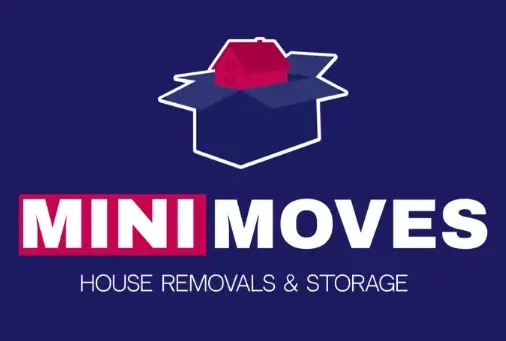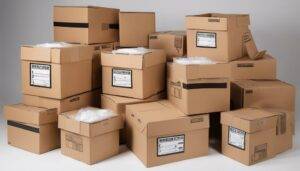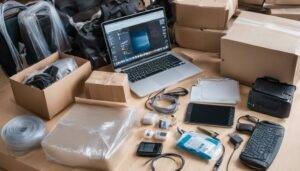Use the Best Packing Supplies
When it comes to packing for a move, we’ve all faced the challenge of choosing the best supplies to keep our belongings safe and secure. From sturdy moving boxes to protective materials like bubble wrap and packing paper, the options can seem overwhelming. We might wonder if local stores like U-Haul and Home Depot are our best bet or if online retailers offer better selections and prices. And let’s not forget the growing trend of eco-friendly options for those of us wanting to minimize our environmental impact. So, where do we start our search for the ideal packing supplies?
Sturdy Moving Boxes
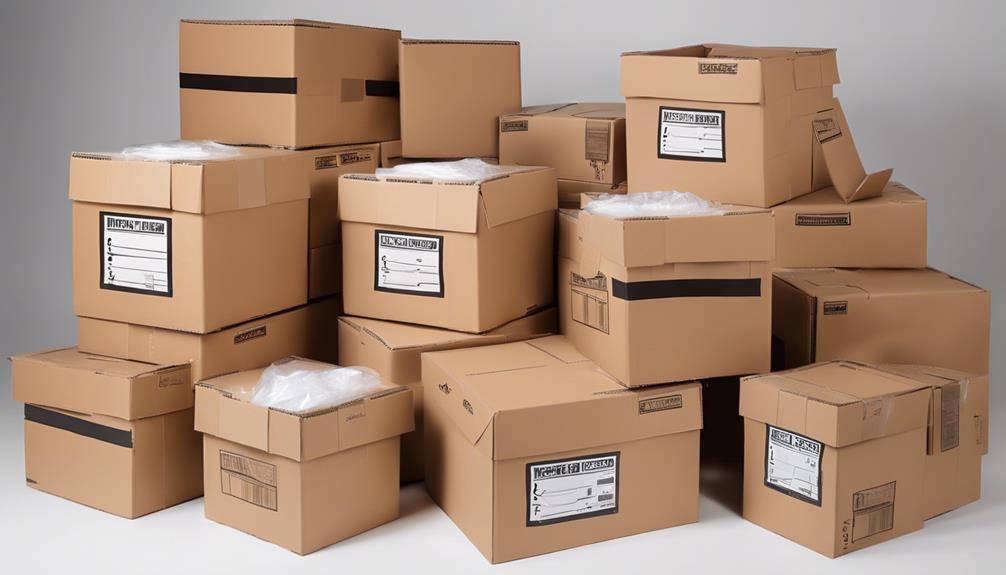
When it comes to moving, having sturdy moving boxes is essential. We all know the stress and chaos that can come with relocating, and the last thing we want is a box giving out on us mid-move. That’s why it’s important to invest in boxes that promise durability.
Box durability isn’t just about thickness; it’s also about how well the box can withstand being stacked and jostled. We should always look for double-walled boxes for heavier items or fragile belongings. These are designed to handle more weight and provide that extra layer of protection. Even for lighter items, single-walled boxes that are reinforced at the seams can greatly reduce the risk of breakage.
Now, let’s talk about eco-friendly options. Nowadays, we can find moving boxes made from recycled materials, and they’re just as strong as their traditional counterparts. By opting for these, we’re not only ensuring the safety of our items but also taking a step toward a more sustainable move. Some companies even offer reusable plastic moving boxes, which can be rented and returned, reducing waste considerably.
It’s worth mentioning that while used boxes might seem like a cost-effective choice, their structural integrity can be compromised. If we go this route, it’s essential to inspect them thoroughly. However, investing in new, high-quality moving boxes, especially those that are eco-friendly, can make all the difference in ensuring our move goes smoothly.
Bubble Wrap
Bubble wrap is a lifesaver when it comes to protecting our fragile items during a move. We’ve all been there, nervously placing our grandmother’s china or that cherished glass vase into a box, hoping it survives the journey unscathed. That’s where bubble wrap comes in, cushioning our breakables with its air-filled pockets.
One of the biggest bubble wrap benefits is its versatility. It can be easily cut to size, wrapped around objects of various shapes, and even layered for extra protection. Plus, it’s lightweight, which means it won’t add much to the overall weight of our boxes. This can be a significant advantage when it comes to keeping moving costs down, especially if we’re paying by weight.
Another benefit of bubble wrap is its reusability. If we’re careful when unpacking, we can save those bubbles for future moves or even for mailing packages. It’s a small way to be eco-friendly while still ensuring our items are safe.
However, bubble wrap alternatives are worth considering too. For instance, packing paper or foam sheets can be just as effective, depending on what we need to protect. Biodegradable packing peanuts and even old newspapers can serve as eco-friendly options. While these alternatives might not offer the same level of cushioning as bubble wrap, they do have their own set of benefits, mainly being better for the environment.
In short, bubble wrap remains a top choice for many of us when it comes to safeguarding our valuables. But exploring bubble wrap alternatives can lead to more sustainable packing solutions without compromising on protection.
Packing Peanuts
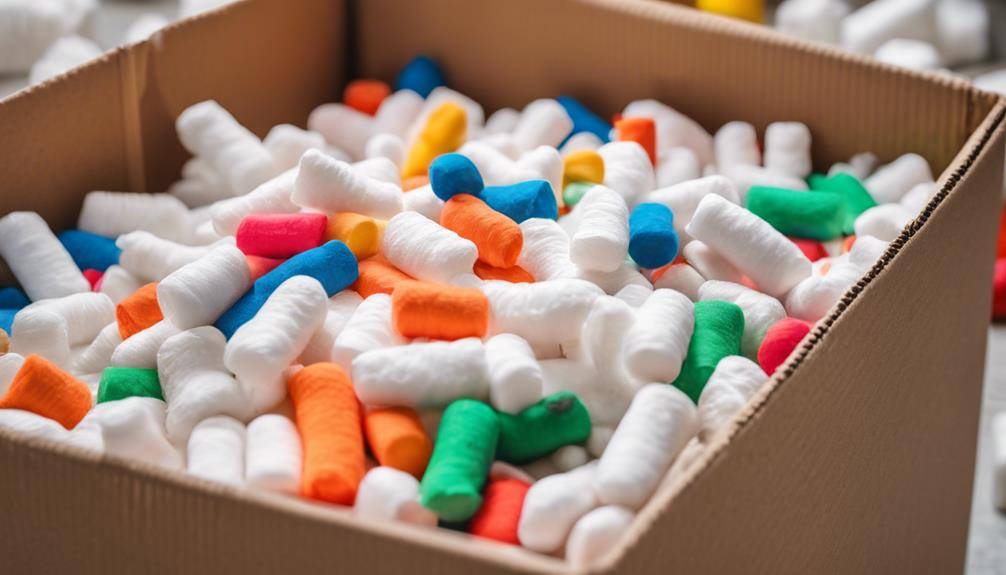
While bubble wrap often serves as our go-to for protecting fragile items, packing peanuts also offer substantial benefits worth examining. These lightweight and versatile fillers are excellent for safeguarding our items during transit. Let’s explore the various types of packing peanuts and look into some eco-friendly alternatives.
First off, we’ve got the traditional Styrofoam packing peanuts. They’re great at cushioning and filling voids in boxes, but they’re not exactly eco-friendly. Styrofoam peanuts can take hundreds of years to decompose, posing significant environmental concerns. That’s why it’s essential to evaluate eco-friendly alternatives.
One such alternative is biodegradable packing peanuts. These are typically made from natural, non-toxic sources like corn starch or wheat. They dissolve in water, making them an excellent option for those of us looking to reduce our environmental footprint. Plus, they offer the same protective qualities as their Styrofoam counterparts without the long-term environmental impact.
Another type of eco-friendly packing peanut is the recycled polyethylene version. Made from post-consumer waste, these peanuts are both reusable and recyclable, offering a more sustainable option without sacrificing durability or cushioning.
When deciding which packing peanut types to use, we should also think about our specific needs. For instance, biodegradable peanuts are perfect for one-time use and can be easily disposed of, while recycled polyethylene peanuts are ideal for those who need a reusable solution.
Packing Tape
Packing tape is an indispensable tool in our arsenal of packing supplies. We all know how vital it is for securing boxes and ensuring our belongings stay safe during transit. With so many packing tape brands and tape dispenser options available, choosing the right one can be overwhelming. Let’s break it down to make it easier for all of us.
Furniture Covers
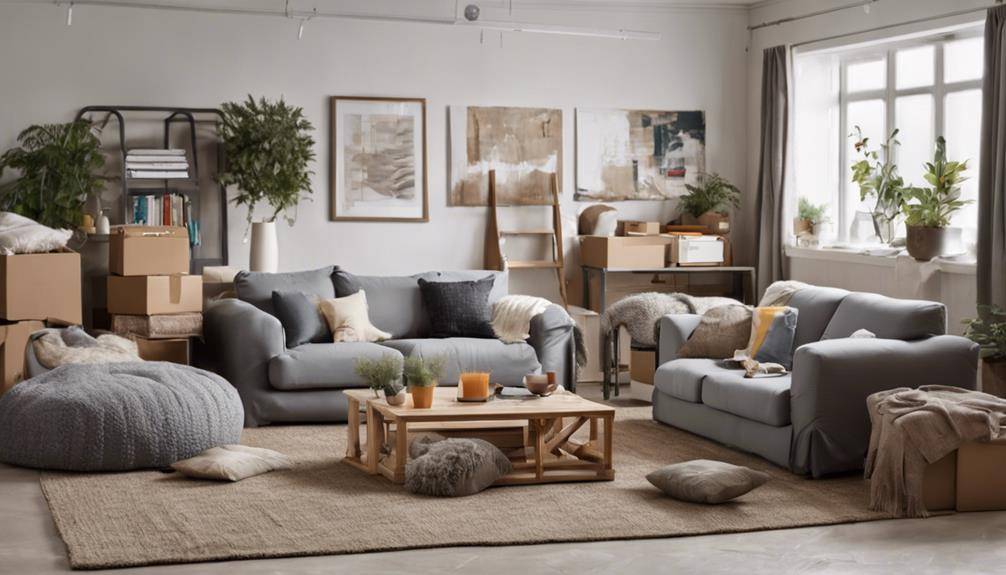
Now let’s talk about furniture covers. We have options ranging from durable materials to more cost-effective choices, and they’re available both locally and online. It’s essential to find the right cover to protect our valuable pieces during the move.
Durable Material Options
Choosing the right material for furniture covers is essential to guarantee durability and protection during a move. We’ve all experienced the frustration of furniture getting scratched or damaged during transport. To avoid this, let’s look at some durable material options that can help keep our furniture safe and sound.
- Heavy Duty Options: When it comes to furniture covers, heavy duty options like canvas or polyester are top choices. These materials are thick, resilient, and can withstand the rigors of moving. They provide an excellent barrier against scratches, dirt, and moisture.
- Eco Friendly Materials: For those of us looking to minimize our environmental impact, there are eco friendly materials like recycled cotton or biodegradable plastics. These options not only protect our furniture but also help us reduce waste and promote sustainability.
- Padded Covers: Another great option is padded furniture covers. These covers often come with extra cushioning, providing additional protection against impact and abrasion. They’re ideal for delicate or valuable pieces that need a little extra care.
Cost-Effective Choices
When it comes to finding cost-effective furniture covers, balancing quality and budget is key. We all want to protect our furniture without breaking the bank, right? Luckily, there are several budget friendly alternatives that don’t compromise on protection. For example, heavy-duty plastic covers are an excellent choice. They’re durable enough to shield against dust and spills, and they’re relatively inexpensive.
But let’s not forget about eco friendly options. If we’re looking to be kind to the planet while keeping costs down, consider reusable moving blankets. Made from recycled materials, these blankets are sturdy and can be used multiple times, which means we’re not contributing to single-use waste. Plus, they often provide better cushioning compared to plastic covers.
Another great budget-friendly option is using old sheets or blankets we already own. While they might not offer the waterproof protection that plastic does, they’re perfect for shielding furniture from scratches and minor dents. This way, we’re repurposing items instead of buying new ones.
Ultimately, by exploring these budget-friendly and eco-friendly choices, we can effectively protect our furniture during moves or storage without spending a fortune.
Mattress Bags
Now, let’s talk about mattress bags and why they’re essential. They protect against moisture, making sure our mattresses stay dry and clean during the move. We’ll also cover some tips for easy transportation and how to pick the right size for a snug fit.
Protecting Against Moisture
One of the most effective ways to protect your mattress from moisture during a move or while in storage is by using mattress bags. These bags act as essential moisture barriers, ensuring that your mattress stays dry and free from mould or mildew. We often underestimate how much humidity can seep into our storage spaces, causing damage over time. By investing in a good-quality mattress bag, we can achieve ideal humidity control and safeguard our valuable bedding.
Here are three key reasons why mattress bags are indispensable for moisture protection:
- Moisture Barriers: Mattress bags are designed to be waterproof, preventing any water or moisture from penetrating and damaging the mattress. This feature is particularly important if the mattress is stored in a damp basement or moved during rainy weather.
- Humidity Control: These bags help maintain a stable environment around the mattress, reducing the risk of mould or mildew growth. This is essential for anyone storing a mattress long-term in areas prone to high humidity.
- Dust and Dirt Protection: While primarily for moisture control, mattress bags also keep dust, dirt, and pests away, providing thorough protection for your mattress during transit or storage.
Easy Transportation Tips
While protecting your mattress from moisture is essential, ensuring it arrives safely at its destination is just as important. Mattress bags are key to handling transportation logistics effectively. They offer a robust layer of protection against dirt and damage during the move. We all know that mattresses can be awkward to manoeuvre, but using a sturdy mattress bag makes the process much easier.
When it comes to efficient loading, the right mattress bag can make all the difference. These bags often come with built-in handles, which can be a lifesaver when we’re traversing tight staircases or narrow hallways. The handles provide better grip and control, reducing the risk of accidental drops or damage. Plus, the bags are designed to be durable, so they won’t easily tear under the weight and pressure of the mattress.
For those of us planning a move, investing in high-quality mattress bags simplifies the whole transportation process. Not only do they protect the mattress, but they also streamline the logistics, making it easier for us to load and unload our items efficiently. Trust us, a good mattress bag is worth every penny when it comes to ensuring a smooth, hassle-free move.
Sizing and Fit Guide
When it comes to choosing the right mattress bag, how do we ascertain we’re getting the perfect fit? It all boils down to understanding the dimensions and types of mattresses we own. A well-fitted mattress bag not only guarantees easier handling but also better protection during the move. Let’s break it down into simple steps:
- Measure Your Mattress: Before purchasing, we need to accurately measure our mattress. Recognizing the length, width, and thickness helps us pick a bag that fits snugly. For example, a Queen mattress typically measures 60″ x 80″, so we should look for a bag that accommodates these dimensions with a bit of extra room for padding.
- Choose the Right Thickness: Mattress bags come in varying thicknesses. Thicker plastic bags offer better protection against tears and punctures. If we’re moving long-distance or storing the mattress for an extended period, opting for a thicker bag could be a wise choice.
- Label Organization: Once our mattress is securely packed, label the bag clearly. This simple packing technique guarantees that we recognize exactly which mattress is inside, making unpacking and organizing a breeze.
Stretch Wrap
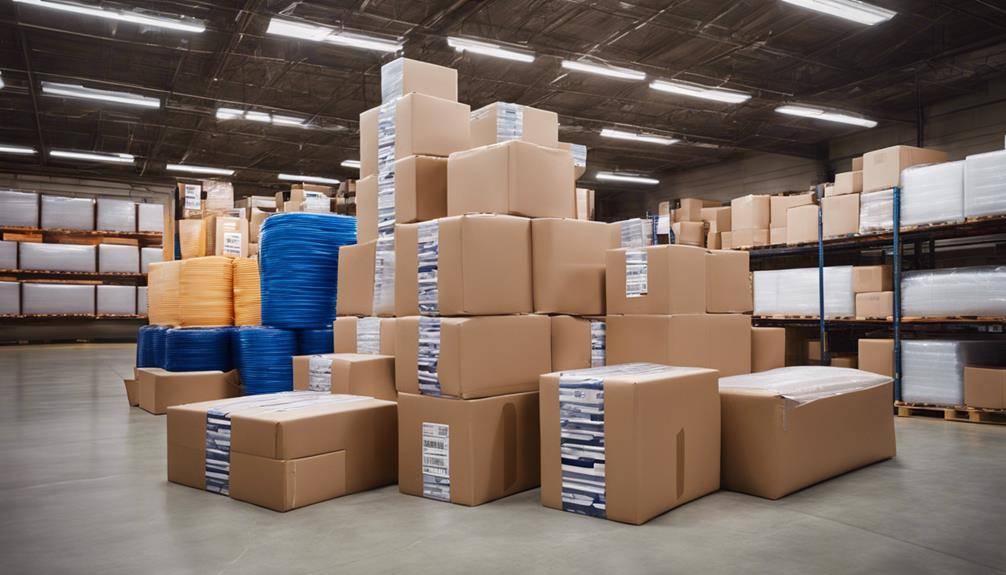
Stretch wrapping is a crucial technique in securing items for transport or storage, ensuring they remain protected and intact. One of the primary stretch wrap benefits is its ability to keep items tightly bound on pallets, preventing them from shifting during transit. This helps in maintaining the integrity of the products, reducing the risk of damage. Additionally, stretch wrap acts as a barrier against dust, dirt, and moisture, making it ideal for long-term storage.
We’ve found that stretch wrap applications are incredibly diverse. Whether we’re shipping large pallets of goods or wrapping individual items to keep them secure, stretch wrap proves to be versatile. For instance, when moving household items, stretch wrap can bundle furniture pieces together, protecting them from scratches and abrasions. In warehouse settings, it’s used to wrap stacks of boxes, ensuring they stay together and making it easier to handle them with forklifts.
When choosing stretch wrap, we need to evaluate the type and thickness to suit our specific needs. There are different types of stretch wrap, such as hand stretch wrap, machine stretch wrap, and even specialty wraps like UV-resistant or coloured stretch wrap. Each type has its unique advantages, so it’s important to select the one that best matches our packing requirements.
Packing Paper
Packing paper is an essential material for safeguarding items during transit or storage. We all know how important it is to keep our belongings safe from damage, and that’s where packing paper comes in handy. It’s versatile and can be used with various packing techniques to guarantee everything stays intact. Plus, there are eco-friendly options available, making it a conscientious choice for the environmentally aware.
When choosing packing paper, it’s important to take into account what you’re packing and how you’ll be using it. Here are three key points to keep in mind:
- Versatility: Packing paper can be used for wrapping fragile items, filling empty spaces in boxes, and even as a cushioning layer. It’s perfect for protecting glassware, ceramics, and other delicate items from scratches and breakage.
- Eco-Friendly Options: Many of us are looking for ways to reduce our environmental footprint. Thankfully, there are packing papers made from recycled materials that are biodegradable. These options are just as effective as traditional packing paper but much better for the planet.
- Cost-Effective: Compared to other packing materials like bubble wrap, packing paper is usually more affordable. It’s a great way to save money without compromising on the safety of your items.
Incorporating packing paper into our packing techniques can save us a lot of hassle and potential heartbreak. Let’s not forget how easy it is to find. Most office supply stores, moving companies, and online retailers carry a variety of options. By choosing the right packing paper, we can guarantee our belongings are protected and do our part for the environment.
Specialty Boxes
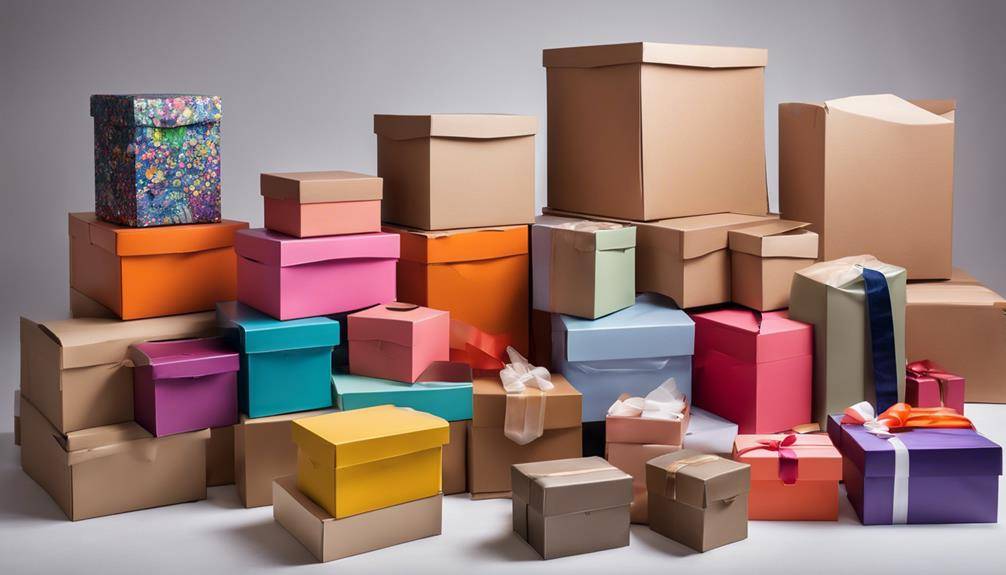
Specialty boxes are often indispensable when it comes to moving or storing items that require extra care. We all have those delicate or uniquely shaped items that standard boxes just can’t handle properly. That’s where specialty boxes come in. From wardrobe boxes for our clothes to dish packs for our fragile kitchenware, these boxes are designed to offer the best protection.
One of the key advantages of using specialty boxes is the availability of custom box solutions. We can find boxes tailored to fit our specific needs, whether it’s for a flat-screen TV, a mirror, or even a bicycle. Custom box solutions guarantee that our items have the right support and cushioning, reducing the risk of damage during transit. It’s comforting to know that our belongings are secure in a box designed just for them.
Additionally, as we become more conscious of our environmental impact, many of us are seeking eco friendly packaging options. Fortunately, many specialty boxes are now made from recycled materials and are designed to be recyclable themselves. This means we can protect our items without compromising our commitment to sustainability. Choosing eco friendly packaging doesn’t just benefit the environment; it also often means the materials are strong and durable, providing excellent protection.
We can find specialty boxes at most moving supply stores, both online and offline. Retailers like U-Haul, Home Depot, and specialized packing stores offer a wide range of options. By investing in the right specialty boxes, we guarantee our items get the care they deserve, making our moving or storage experience smoother and stress-free.
